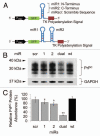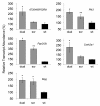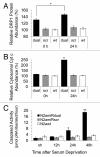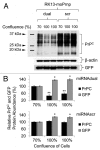Establishment and characterization of Prnp knockdown neuroblastoma cells using dual microRNA-mediated RNA interference
- PMID: 21494092
- PMCID: PMC3166508
- DOI: 10.4161/pri.5.2.15621
Establishment and characterization of Prnp knockdown neuroblastoma cells using dual microRNA-mediated RNA interference
Abstract
Prion diseases are fatal transmissible neurodegenerative disorders. In the pathogenesis of the disease, the cellular prion protein (PrPC) is required for replication of abnormal prion (PrPSc), which results in accumulation of PrPSc. Although there have been extensive studies using Prnp knockout systems, the normal function of PrPC remains ambiguous. Compared with conventional germline knockout technologies and transient naked siRNA-dependent knockdown systems, newly constructed durable chained-miRNA could provide a cell culture model that is closer to the disease status and easier to achieve with no detrimental sequelae. The selective silencing of a target gene by RNA interference (RNAi) is a powerful approach to investigate the unknown function of genes in vitro and in vivo. To reduce PrPC expression, a novel dual targeting-microRNA (miRdual) was constructed. The miRdual, which targets N- and C- termini of Prnp simultaneously, more effectively suppressed PrPC expression compared with conventional single site targeting. Furthermore, to investigate the cellular change following PrPC depletion, gene expression analysis of PrPC interacting and/or associating genes and several assays including proliferation, viability and apoptosis were performed. The transcripts 670460F02Rik and Plk3, Ppp2r2b and Csnk2a1 increase in abundance and are reported to be involved in cell proliferation and mitochondrial-mediated apoptosis. Dual-targeting RNAi with miRdual against Prnp will be useful for analyzing the physiological function of PrPC in neuronal cell lines and may provide a potential therapeutic intervention for prion diseases in the future.
Figures







Similar articles
-
Utility of RNAi-mediated prnp gene silencing in neuroblastoma cells permanently infected by prions: potentials and limitations.Antiviral Res. 2009 Nov;84(2):185-93. doi: 10.1016/j.antiviral.2009.09.002. Epub 2009 Sep 11. Antiviral Res. 2009. PMID: 19748523
-
Knockdown of prion protein (PrP) by RNA interference weakens the protective activity of wild-type PrP against copper ion and antagonizes the cytotoxicity of fCJD-associated PrP mutants in cultured cells.Int J Mol Med. 2011 Sep;28(3):413-21. doi: 10.3892/ijmm.2011.688. Epub 2011 May 2. Int J Mol Med. 2011. PMID: 21537833
-
Prnp knockdown in transgenic mice using RNA interference.Transgenic Res. 2008 Oct;17(5):783-91. doi: 10.1007/s11248-008-9179-2. Epub 2008 Mar 19. Transgenic Res. 2008. PMID: 18350371
-
Prions: pathogenesis and reverse genetics.Ann N Y Acad Sci. 2000;920:140-57. doi: 10.1111/j.1749-6632.2000.tb06916.x. Ann N Y Acad Sci. 2000. PMID: 11193143 Review.
-
Biology of the prion gene complex.Biochem Cell Biol. 2001;79(5):613-28. doi: 10.1139/o01-142. Biochem Cell Biol. 2001. PMID: 11716303 Review.
Cited by
-
CATS (FAM64A) abnormal expression reduces clonogenicity of hematopoietic cells.Oncotarget. 2016 Oct 18;7(42):68385-68396. doi: 10.18632/oncotarget.11724. Oncotarget. 2016. PMID: 27588395 Free PMC article.
-
Stable overexpression of native and artificial miRNAs for the production of differentially fucosylated antibodies in CHO cells.Eng Life Sci. 2024 Apr 1;24(6):2300234. doi: 10.1002/elsc.202300234. eCollection 2024 Jun. Eng Life Sci. 2024. PMID: 38845814 Free PMC article.
-
Dual MicroRNA to Cellular Prion Protein Inhibits Propagation of Pathogenic Prion Protein in Cultured Cells.Mol Neurobiol. 2018 Mar;55(3):2384-2396. doi: 10.1007/s12035-017-0495-5. Epub 2017 Mar 29. Mol Neurobiol. 2018. PMID: 28357807
-
Downregulation of cellular prion protein inhibited the proliferation and invasion and induced apoptosis of Marek's disease virus-transformed avian T cells.J Vet Sci. 2016 Jun 30;17(2):171-8. doi: 10.4142/jvs.2016.17.2.171. J Vet Sci. 2016. PMID: 26243599 Free PMC article.
-
Advantages of Structure-Based Drug Design Approaches in Neurological Disorders.Curr Neuropharmacol. 2017 Nov 14;15(8):1136-1155. doi: 10.2174/1570159X15666170102145257. Curr Neuropharmacol. 2017. PMID: 28042767 Free PMC article. Review.
References
-
- Basler K, Oesch B, Scott M, Westaway D, Walchli M, Groth DF, et al. Scrapie and cellular PrP isoforms are encoded by the same chromosomal gene. Cell. 1986;46:417–428. - PubMed
-
- Trevitt CR, Collinge J. A systematic review of prion therapeutics in experimental models. Brain. 2006;129:2241–2265. - PubMed
-
- Nuvolone M, Aguzzi A, Heikenwalder M. Cells and prions: a license to replicate. FEBS Lett. 2009;583:2674–2684. - PubMed
Publication types
MeSH terms
Substances
LinkOut - more resources
Full Text Sources
Other Literature Sources
Medical
